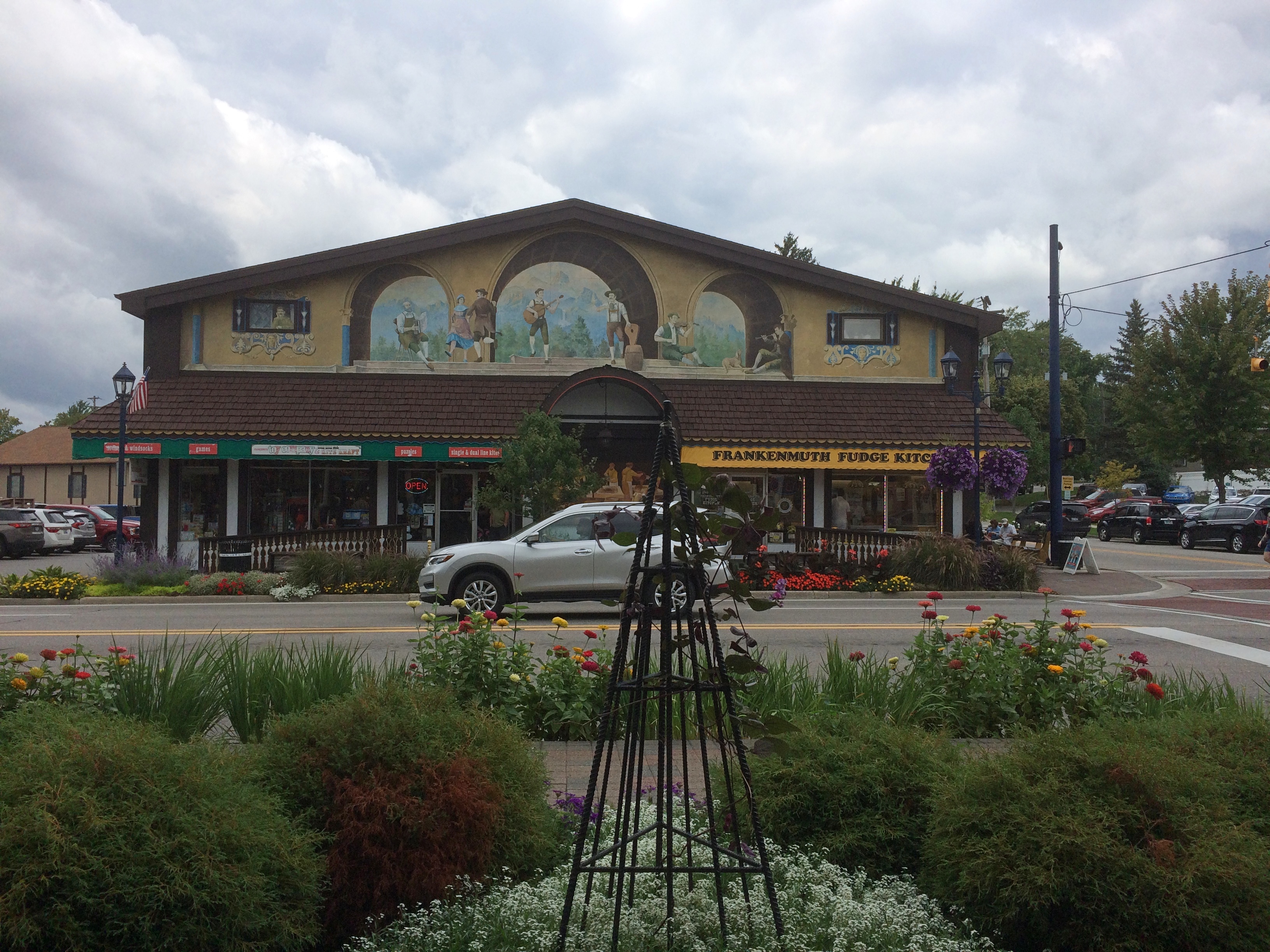One thing I didn’t expect while we strolled along Main Street in Frankenmuth, Michigan, on Labor Day — yet another walkable main street — was a life-sized bronze of a fudge maker. Yet there he is.
 According to the plaque, it’s Gary F. McClellan (1940-2015), “entrepreneur, leader, friend, husband and father.” He must have had something to do with Zak & Mac’s Chocolate Haus, which is behind the statue. That’s one of a string of small stores along the street whose customers are the tourists who come to Frankenmuth, a farm town settled by Bavarians in the 19th century that eventually added a tourist component.
According to the plaque, it’s Gary F. McClellan (1940-2015), “entrepreneur, leader, friend, husband and father.” He must have had something to do with Zak & Mac’s Chocolate Haus, which is behind the statue. That’s one of a string of small stores along the street whose customers are the tourists who come to Frankenmuth, a farm town settled by Bavarians in the 19th century that eventually added a tourist component.
 A successful component, I’d say. Lots of people had come to town on Labor Day.
A successful component, I’d say. Lots of people had come to town on Labor Day.
 I’d read a little about the settlement of the area by Bavarians, interestingly before 1848, as an Indian mission that never really panned out because most of the Indians were already gone by then. Even so, the doughty colonists stayed. Their descendants are probably pretty thick on the ground in this part of the state.
I’d read a little about the settlement of the area by Bavarians, interestingly before 1848, as an Indian mission that never really panned out because most of the Indians were already gone by then. Even so, the doughty colonists stayed. Their descendants are probably pretty thick on the ground in this part of the state.
Modern visitors come to wander through the shops, many with that Bavarian look. That’s what we did.


 Also they come to eat.
Also they come to eat.
 So did we. In fact we had Zehnder’s chicken, though we took a to-go family pack to a picnic table behind the restaurant: fried chicken, beans, macaroni, potato salad, rolls. Aside from a few interrupting bees, we enjoyed it.
So did we. In fact we had Zehnder’s chicken, though we took a to-go family pack to a picnic table behind the restaurant: fried chicken, beans, macaroni, potato salad, rolls. Aside from a few interrupting bees, we enjoyed it.
Frankenmuth also sports such sights as a maypole fountain, a popular place for posing.
 Later I read a little about Bavarian maypoles. The idea is similar to English maypoles, but not quite the same. Maybe that’s the real source of dispute between the UK and the EU — the regulation of maypoles. Just a thought.
Later I read a little about Bavarian maypoles. The idea is similar to English maypoles, but not quite the same. Maybe that’s the real source of dispute between the UK and the EU — the regulation of maypoles. Just a thought.
In the various sources that I’ve consulted — skimmed — the early history of Frankenmuth gets some attention, such as in this short history of the place. But modern Frankenmuth, that is, its invention as a tourist town after World War II, gets short shrift. To my way of thinking, that’s as interesting as its history as a German colony in Michigan.
There are some hints here, however, in the Frankenmuth media kit, of all places. From the “significant dates,” you learn that Zehnder’s Restaurant, which is a sprawling place with a lot of dining rooms, got its start as the Exchange Hotel in 1856. Another 19th-century hotel, Fischer House, later became the Bavarian Inn, also with a large restaurant.
When did Frankenmuth start playing up its Bavarian-ness? Looks like the 1950s.
From the timeline: 1957: Rupprecht’s Sausage was the first building decorated in the “Bavarian” architecture. 1958/59: Zehnder family… redecorates the Fischer Hotel in Bavarian architectural style. 1960 & Current: More buildings adopt “Bavarian” architecture.
A Bavarian Festival started in 1963 but the town didn’t around to an Oktoberfest until 1990. In 2001, a Bavarian-themed mall opened south of the Cass River along Main Street.
Sounds like a few places — the chicken restaurants — were long-time draws. After all, metro Detroit and the once-prosperous Flint aren’t that far. But in the postwar age of auto tourism, the town’s merchants happened on a winning formula of more than just chicken, one that dovetailed with the town’s origin: faux Bavaria.
That might sound like criticism of Frankenmuth as “inauthentic,” a vague epithet if there ever was one, but I refuse to go down that road.
Of course the place isn’t really Bavarian. No one thinks that. Visitors respond to it as a pleasant place to be. People were out and about on a summer day, having an innocuous good time, and supporting businesses that exist here and nowhere else. You could call it an homage to Bavaria, but in any case it’s an authentic American town with a popular theme.
